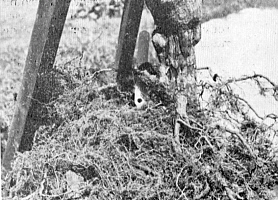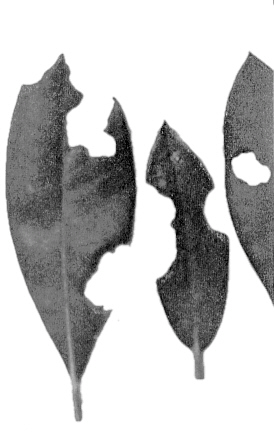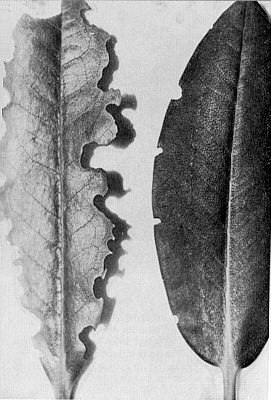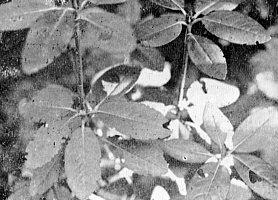QBARS - v25n2 Weevils and How They Bug Me
Weevils and How They Bug Me
Carl H. Phetteplace, M.D., Eugene, Oregon
At meetings and in writings concerned with growing rhododendrons there is usually some portion devoted to Brachyrhinus or root weevil, its damage to plants and measures for its control. For many years this has been of little interest to me because even though there is scarcely a plant in my garden that does now show at least a few leaves with the tell-tale marginal notching of this pest, my erroneous impression has been that except for some relatively harmless disfigurement of the leaves and an occasional girdling of a small plant below the soil level, weevils really did no serious harm.
Another reason for my lack of concern was finding that poison baits and insecticides such as chlordane and aldrin, so widely recommended years ago, proved a waste of time, labor and money. A friend of mine once grew a crop of healthy weevil larvae in glass containers filled with fine soil, heavily laced with chlordane. At that time neither he nor I knew that there were more than one kind of weevil and consequently no attempt was made at specific identity.
A few years ago a very large and handsome plant in my garden began to deteriorate despite good soil conditions and coddling with trace elements, iron, and other "goodies" to make a plant flourish. One thing was especially notable. An unusual number of its leaves, mainly on lower branches, exhibited the typical serrations of weevil activity. In FIG. 40 the left leaf shows one such disfigurement. Digging about the finer root system, even sifting some of it, many small grayish white grubs or larvae were found. Still being unaware of more than one weevil no attempt at identification was made.

|
|
Fig. 42. This plant is Rock # 16 which has
been almost completely girdled years ago two or 3 inches below soil level only discovered by lifting the plant. (The stakes supporting the plant are ¾" in size.) Carl H. Phetteplace, M.D. photo |
A second awakening experience concerned a very interesting plant, Rock #16, grown from seed since 1948, a species not yet identified. For years portions of the plant failed, necessitating some cutting back. Its general condition steadily deteriorated. Feeling that it would inevitably die, the entire plant was lifted and carried to a remote spot and all soil was thoroughly hosed from the root system. FIG. 42 shows what had been going on below the soil level. There was almost complete girdling, probably done years before. Fortunately one healthy branch about one-half inch in diameter had grown below the girdle with its own good system. This has been cut loose and planted elsewhere and is doing well. Incidentally there were no notched leaves on this rather thick, leathery leafed species but there were many on neighboring plants of different varieties.
Such experiences prompted me to review some of our own American Rhododendron Society literature published over the years, as well as other sources. This was very rewarding. The subject of weevils is admirably presented in articles in "Rhododendrons 1956" 1 and in "Rhododendron Information" 2 by Dr. E. P. Breakey along with excellent bibliographies. Of course the subject is comprehensively covered by Dr. David Leach in "Rhododendrons of the World "3 . The following draws freely from these sources and others to which is added some of my personal garden observations.
I. Weevils are perhaps the most serious and widespread of all insect pests affecting rhododendrons. They can do great damage, the worst of which is below the soil level rather than on the foliage.
II. They are an old and difficult problem as shown by records about them written in Germany and Great Britain over one hundred years ago. 2
III. There is not just one weevil, but several. Brachyrhinus, perhaps is commonest in most gardens and consists of three separate species. Illustration of these were shown by Knowlton and James 4 and reproduced by Dr. Breakey 1 . They are B. ovatum, B. rugostriatus and B. sulcatus . They are similar in appearance, life cycle and habits except they are increasingly larger in the order mentioned. Leach 3 states that no males of the species have ever been found. Perhaps there are none. This form of reproduction from eggs unfertilized by the male is known as parthenogenesis. Is it possible that the current agitation for more feminine freedom may eventually lead to some such phenomenon in the human race?
IV. There are two species which do not belong to the Brachyrhinus group and are called "woods weevil." They are Nemocestes incomptus and Scioptes obscurrus which have been described by Dr. R. E. Warner of the U.S.D.A., Beltsville, Md., and referred to by Dr. Breakey 2 .
V. All together they emerge from the larvae which feeds and develops on the fine roots and even the bark of the host plant to the active leaf-eating weevil stage at a wide range of times - Brachyrhinus for the most part from May to September. The "woods weevil", however, may emerge at almost any time of the year 2 .
VI. During the larvae stage they feed extensively on the roots of the plant and even the bark.
VII. No substance is known, which does not kill the plant itself, which will kill the larvae or grubs in the ground 1 .
VIII. Very little, if any, evidence of weevil activity has been noted in my garden on rhododendrons having a thick, heavy foliage such as R. coriaceum and R. yakushimanum . Thin leafed varieties such as our native R. macrophyllum and R. ponticum itself have shown extensive damage.

|

|
|
FIG. 39. These leaves could represent
wood weevil damage but other pests might do similar damage. |
FIG. 40. The leaf on the left shows probably
all the feeding one adult Brachyrhinus may do. On the right probably several have fed before dropping their eggs and falling to the ground. |
IX. Brachyrhinus is a dainty feeder, one weevil probably not using more than a few nibbles from the margin of the leaf. Extensive damage probably represents a dense population of the pest. The leaf on the right of FIG. 40 may be all a single weevil will eat, that on the left probably represents the work of many.
X. To the best of my knowledge Brachyrhinus always feeds on the margins of the leaves as here shown. She is a nocturnal feeder and may be caught in the act at night by searching with a flashlight. "Woods weevil" being more voracious may eat large margins or even holes in the leaf as shown in FIG. 39. The plant shown in FIG. 41 probably has been the victim of both the "vine weevil" and the "woods weevil." However, worms, caterpillars and even slugs may do similar damage.

|
|
FIG. 41. This plant grown near several
native trees and shrubs has probably been host to both Brachyrhinus and "wood weevil." |
XI. The "woods weevil" (and probably to some extent Brachyrhinus) feed on a great many native and domestic shrubs such as salal, camellia, salmonberry leaves, primula, young cascara and even small Douglas firs.
Although Brachyrhinus is a sluggish insect and usually drops her eggs to the ground anywhere under the host shrub, the "woods weevil" by contrast is much more active and voracious. She may move from plant to plant and usually deposits her eggs on the margins of the leaves where they may hatch, then fall to the ground. They may develop to emerge as weevils throughout the full calendar year (Breakey 2 ). Obviously no treatment can prevent new populations of "woods weevils" from moving into a garden situated in a woodland setting from the native plant material nearby. In addition to this problem an insecticide effective for one variety of weevil may be quite useless with others. Add to this the current worry about ecology and toxic pesticides and we indeed have a puzzle.
Despite having in my garden signs of more weevils every year the knowledge obtained in attempting to learn what could best be done prompted me to submit what I can in the hope that it may be of some help to our younger members, who comprise; a relatively large part of our Society. It is with apologies to our trained entomologists that as a layman these suggestions are offered.
If there is evidence from the appearance of a plant that it is deteriorating or not showing normal vigor try to determine what is going on beneath, the soil level. Here is where most things that are deadly take place, anyway. Possibly by sifting the soil weevil larvae may be found. Your local County Agricultural Agent or any, known entomologist may be of great assistance.
Have no fears about taking up, a, plant with its entire root system (if. it is not too large to handle) and forcibly hosing off the roots so as to remove all soil. Once a plant begins, to look sick it almost always proceeds, to a fatal end anyway unless properly treated. Indeed, you may find that it is already dead even though there; is still green foliage. Nothing can be lost in this type of handling, though it may seem drastic.
For control of weevils as has already been mentioned the use of poisoned baits such as "Go West " and chlordane and lindane have been disappearing, although strawberry growers have had good success with some of these agents. Stomach poisons such as arsenic compounds have never been recommended because of the dainty feeding habits (FIG. 40 left leaf) of Brachyrhinus and for other reasons.
In 1955 Eide 5, 2 showed that aldrin, dieldrin heptachlor and chlordane gave good control of Brachyrhinus for two years when mixed into the soil; while D.D.T., Benzene Hexachloride (B.H.C. or Lindane) and Methoxychlor failed to control in any amounts tested. Breakey 2 found that heptachlor and aldrin were still giving good control five years after application. Lindane, though generally considered one of the most toxic of all agents, gave only partial control and is not recommended. If Brachyrhinus is suspected one of the most recommended insecticides should be incorporated into the soil when setting the plant out in the beginning.
The "woods weevil", which probably most of us in the Pacific Northwest have along with Brachyrhinus, is apparently resistant to the pesticide of choice for Brachyrhinus. Parathion as well as D.D.T. perhaps have a spectrum of effectiveness best suited for both pests. The former is reported to be highly toxic to birds, bees and other wild life as well as being so toxic to handle that it is not recommended for use by any but a trained operator. The latter is so persistent and toxic that it is being banned by law.
Our local County Agents at one time advised that in his opinion the pesticide with a good spectrum of effectiveness yet not too dangerous to use was Diazinon. It deteriorates after about two months and, therefore; must be applied at least twice a year - perhaps May and August. It, too, is toxic to bees, birds and even the operator 7 , but if used as a soil drench according to directions and the operator uses reasonable care the dangers should be minimum.
At one time we grew rhododendrons and azaleas in a carefree manner, rejoicing that one need never have the bother of spraying or other tasks to keep them healthy, such as rose growers must contend with. Rapidly we are learning of a variety of problems to mar our bliss. Apparently this is a price we must pay for congestion, and increasingly widespread desire of people to share our enjoyment of this genus. Growing plants in areas where climatic and soil conditions are less than optimum contributes to problems, also. There is apparently no end of work for our Research Committee with which to wrestle but there is no doubt in my mind that it is possible to grow more and more beautiful rhododendrons in even widening horizons of the world. It seems increasingly apparent that breeding strains of rhododendrons that are resistant or immune to growing problems encountered in particular areas rather than striving to find the multiplicity of remedies that might be devised is the direction we should head for. For instance, there are several rather leathery leafed species in my garden which have no leaf notching. If we can fly to the moon surely we will not be permanently "bugged" by a variety of problems which are now only beginning to come to our attention in a general way.
Below is a list of authors and their publications to whom I wish to give credit and my thanks. It seemed that it might be of value to put some of their findings in one "package" so that our members and readers of the Bulletin might not be so slow in learning about weevils as I have been.
1 Breakey, Insect Pests of Rhododendrons and Azaleas, Rhododendrons, 1956, American Rhododendron Society, pp 44 and 50.
2 Breakey, Insect Pest of Rhododendrons and Azaleas, Rhododendron Information, American Rhododendron Society, 1967, pp 188-191.
3 Leach, Rhododendrons of the World, Chas. Scribner's and Sons, pp 304-306.
4 Knowlton, George F. and Jones, Ray L., 1941, Control of Strawberry Root Infecting Weevils, Proceedings of the Utah Academy of Sciences Arts and Letters, 18:23.29.
5 Eide, P. M., 1952, Soil Treatments for Strawberry Weevil Control, Proceedings of the Western Washington Horticultural Assn., Jan. 1952, 43:7.
6 Fide, P., If. 1955, Soil Treatments for Brachyrhinus Control in Strawberries, Jour. Econ. Ent., 48:207.8.
7 DeWolf, What Can We Do About Pollution?, Arnoldia, Vol. 30 No. 2, 1970: 33.
8 Hall, Page, Lane County Agricultural Agent, Personal Communication.
